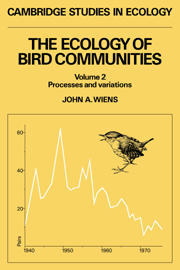Part II - Community variation in time and space
Published online by Cambridge University Press: 18 December 2009
Summary
Many of the views of communities that developed during the 1960s and early 1970s portrayed a dream world of stability and homegeneity, in which spatial or temporal variations in environments were either nonexistent or were closely matched by responses of the community. To a large degree, these views were nutured by the mathematical constructs of community theory, which operated under the assumption that models reflecting a world in stable equilibrium and having no spatial dimension were reasonable representations of natural communities. Because natural communities were thought to tend strongly toward equilibrium, the effects of history disappeared, environmental perturbations had no lasting effects, spatial heterogeneity was of little consequence, and chance was limited to a small role in affecting the dispersal of species to a locality (Chesson and Case 1986).
But of course environments and communities do vary in time and space. They do so with varying amplitudes, periodicities, and degrees of stochasticity, on a wide range of scales. Communities vary in the presence and absence of species, in the density levels of these species, and in their densities relative to one another. Because the stability and predictability of other aspects of ecological relationships among the species hinge on the relative constancy of these patterns, such variability hinders attempts to detect and explain community patterns. This temporal and spatial variation of communities, although perhaps not entirely ‘music to the ecologist’ (Simberloff 1982a), at least can no longer be considered simply as uninteresting and unwanted ‘noise’, to be muffled by statistical analysis or simply disregarded altogether.
- Type
- Chapter
- Information
- The Ecology of Bird Communities , pp. 141 - 142Publisher: Cambridge University PressPrint publication year: 1989



